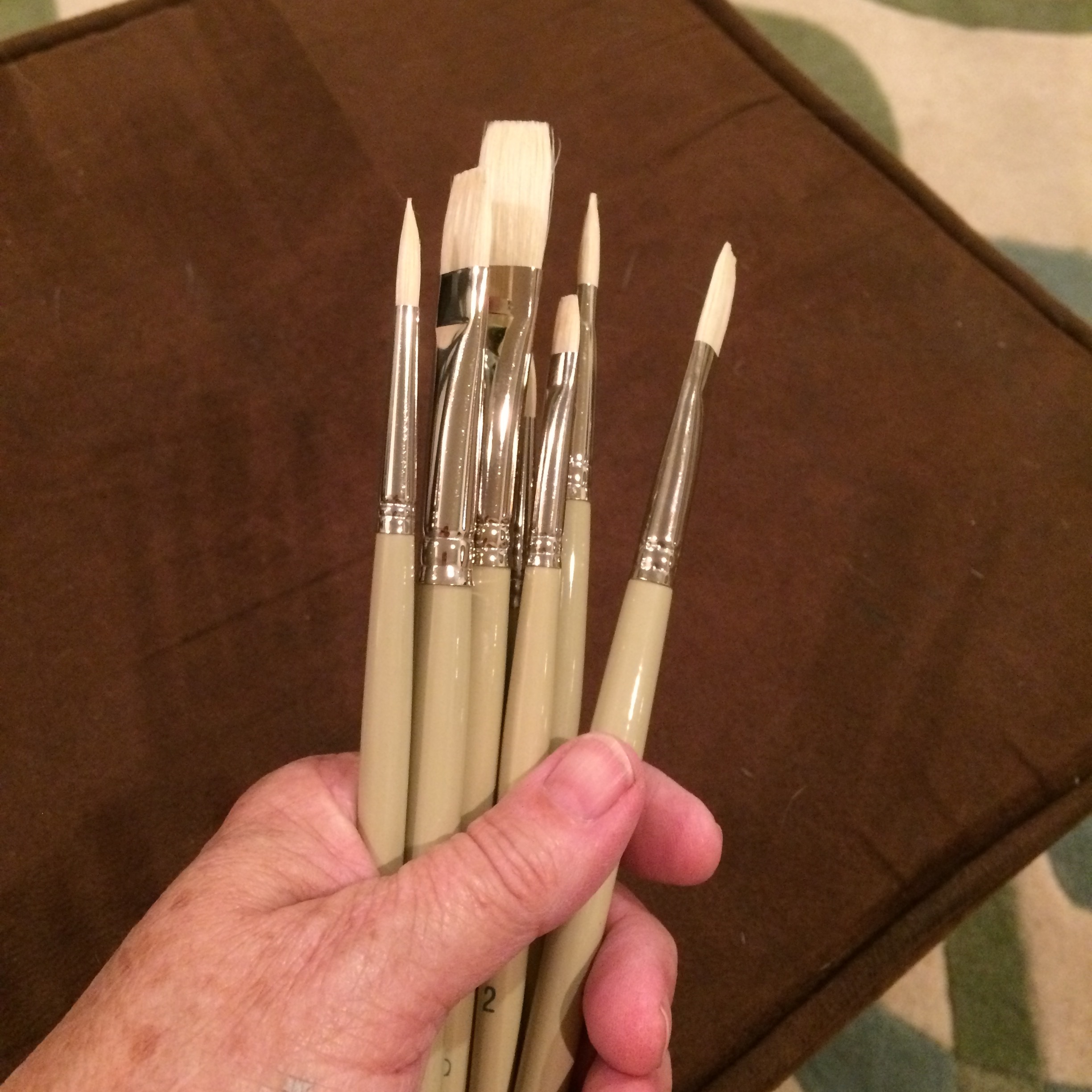The True Story of How to Clean Your Acrylic Paint Brushes
There's a lot of information out there on the Internet highway, some good, some bad, some so-so. But I don't recall ever seeing The True Story of How to Clean Your Acrylic Paint Brushes. I thought I'd relay it here and put to rest some of the rumors around this ancient myth.
First my pet peeve is the rumor that you should clean your paintbrushes in the palm of your hand. What? NEVER CLEAN YOUR BRUSHES IN THE PALM OF YOUR HAND! Why? Because you are embedding pigment into your skin. Duh. I see this over and over again. Please don't do this. I believe there was an entire tribe of Ancient Artists who lost the ability to sing falsetto because they intentionally cleaned their paintbrushes in the palm of their hands. But this could be another false rumor.
It is a well known fact that cleaning your paintbrushes under running water will send the Muse screaming from your studio for at least two weeks. She's really fussy about this one. So beware! NEVER CLEAN YOUR BRUSHES UNDER RUNNING WATER! Why again? Because you are sending paint solids down the drain. Bad for the fishies, bad for your plumbing.
So, how should you clean your brushes? Read on my darlings. This is ancient knowledge, handed down over the generations. Guard it carefully!
First of all, regard your paintbrushes as the friends and helpers that they are. They are kind and willing to work for you, don't abuse them! Don't beat them up! What did they ever do to you except help you make fabulous art? Love them and they will serve you well. Until you leave the studio and then they use up all of your cell data and order pizza. But I digress....
Okay, but really....
Number one: Don't let acrylic paint dry on your brush. If you do, kiss the brush goodbye and make a sculpture with it. And feel really, really guilty about killing a paintbrush. They scream you know.
Next, put aside the time to clean your brushes when you paint. Don't just stand them in the water and haul ass out of the door to meet someone at Starbuck's. When you come back your paintbrushes will be a limp, soggy shadow of their former selves and perhaps will be going bald (losing bristles). The bristles of the brush will wick up the water into the ferrule (that metal thingie that holds the bristles in place) and loosen the glue that is also holding the bristles. Then the paintbrush will lose its hair. Really embarrassing for a paintbrush. Don't put them through this. Their paintbrush friends will point and laugh.
Proper cleaning of your paintbrush:
1. Wipe off all of the paint solids possible from the brush. Use old telephone books (do they still make those?) paper towels, old rags, whatever. Don't be lazy, really get all of the paint off of the brush. No, that's not enough, do it again.
2. Next, rinse the brush in a BUCKET of water. We will refer to this as Bucket #2. You may want to write this down. You have to keep track of your buckets, you know. You will have two to three buckets of water so get prepared.
3. Now get a bar of artist's soap like The Masters Hand Soap-4.5 Ounces and rub the brush across that a couple of times. The brush really loves this! If you listen closely you can hear the brush giggle when you do this.
4. Now swish the brush in Bucket #2 again a few times. LOL, swish.
5. Back across the soap. Swish again. Brushes love to swish. They're natural born swishers. It comes from being bunched up in that old peanut butter jar on the studio table. Once they get outta there they swish like crazy!
6. Finally, rinse the brush in Bucket #1 clean, clear water.
7. The brush should be fairly clean now. You can examine it with your fingers, but be polite!
8. Now gently lay your brush down on a clean paper towel or bath towel. Perhaps one with the brush's name embroidered on it. Never leave your damp brushes standing upright to dry. It really wrecks their hair! And again, they could lose bristles from the water going down into the ferrule and loosening the glue. It's a lotta work being a paintbrush!
9. Put aside Bucket #2. It may be slightly soapy. That's okay. Use it the next time you clean your brushes. Once it gets all gunky with paint, pour it off into Bucket #3 that will be reserved for "dirty water". Let this water evaporate. Yes it will take days to evaporate, maybe weeks. But you don't have to stand there and watch it! Go paint something! When the water is all gone, wipe up the sludge that is left behind and put it in the trash.
10. No paint down the sink and no fishies turning Quinacridone Magenta!
12. Keep a bucket of clean water for step #6 above. This is Bucket #1.
13. Once Bucket #1 gets too dirty, pour it into Bucket #2. Don't pour it into Bucket #3, the dreaded "dirty water" bucket. Don't wash your brushes in Bucket #3! It's for pouroff only! Stories abound among the older brushes about young brushes that mistakenly fell into Bucket #3, never to be seen again. Then came time to clean out the sludge. And there, laying in the bottom of Bucket #3, the young, foolish, brush - bristles all gunky, paint chipped off the handle, name no longer readable. Oh the horror!
So Bucket #1 becomes Bucket #2 and Bucket #2 goes into Bucket #3. Follow? No? Well find an old paintbrush that knows the ropes and have it show you the way.
That's the story the way I heard it. But granted, it was an Ancient Paintbrush that related this tale to me. She had a bit of Matte Medium stuck to her so her memory could have been cloudy. That paintbrush has passed on into the other world, where paintbrushes are always young and clean.
Sometimes, when I'm leaving the studio, after I turn out the lights, I stop at the door and listen. I can hear the brushes singing their Ancient song, summoning the Muse to my studio for the next day.
They can only sing when they're clean you know.
UPDATE: If you have been a bad artist, and let paint dry on your brushes you CAN bring them back to life. Soak them overnight in Bristle Magic and then wash them as above. Voila! You’ve just resurrected your dead paintbrush!
Want more tips? Check out my books on Amazon, Barnes and Noble and Walmart.



